Detailed description of Division I ice hockey concussions:Findings from the NCAA and Department of Defense CARE Consortium
Katryn L.Van Pt*,Jayn B.Cas,Jas T.Enr,Marot Putuan,M.Ason Broos,Knnt L.Caron,Man N.Houston,Mattw A.Posnr,Jonatan C.Jason,Gra T.MGnty,Caron J.Hs,Toas W.MAstr,Ma A.MCra,Stvn P.Broo,Toas A.Buy
a Sanders-Brown Center on Aging,University of Kentucky,Lexington,KY 40536-0230,USA
b College of Medicine School of Health and Rehabilitation Sciences,The Ohio State University,Columbus,OH 43210,USA
c Department of Physical Medicine and Rehabilitation,Michigan Medicine,University of Michigan,Ann Arbor,MI 48108,USA
d University Health Services,Princeton University,McCosh Health Center,Princeton,NJ 08544,USA
e Department of Orthopedics and Rehabilitation,Department of Pediatrics,University of Wisconsin School of Medicine and Public Health,Madison,WI 53705-2281,USA
f Keller Army Hospital,United States Military Academy,West Point,NY 10996,USA
g 10th Medical Group,United States Air Force Academy,Colorado Springs,CO 80840-4000,USA
h Sports Medicine,Athletic Department,United States Air Force Academy,U.S.Air Force Academy,CO 80840-9500,USA i Novant Health,Charlotte Independence Soccer Club,Cornelius,NC 28031,USA
j Department of Psychiatry,Indiana University,Indianapolis,IN 46202,USA
k Neurosurgery,Medical College of Wisconsin,Milwaukee,WI 53226,USA
l Michigan Concussion Center,University of Michigan,Ann Arbor,MI 48109,USA
m Kinesiology and Applied Physiology,University of Delaware,Newark,DE 19713,USA
Abstract
Keywords: Concussion risk;Injury mechanism;Recovery
1. Introduction
Concussion is the most commonly reported injury in ice hockey,1with an estimated rate of 0.74 concussions per 1000 athlete exposures.2Understanding concussion risk factors and mechanisms of injury can generate rule changes to potentially reduce ice hockey concussion incidence.However,most of the research investigating concussion risk factors and mechanisms of injury in ice hockey have exclusively looked at male professional3or predominately male elite amateur ice hockey players.4-6Despite the fact that women’s ice hockey is a rapidly expanding sport,growing at a rate 6.5 times faster than men’s ice hockey,7few studies have evaluated ice hockey concussion mechanisms among both male and female athletes.1,8,9With increasing female participation in ice hockey,it is important to evaluate whether there are differences in concussion mechanisms and clinical presentations between the sexes.
Often,in comparable sports(e.g.,soccer and basketball),female athletes have a higher concussion incidence than their male counterparts.10However, despite rule differences between women’s and men’s ice hockey,males and females have similar concussion rates in the sport.10Factors other than sex are thought to contribute to concussion risk, e.g., previous concussion, which has been shown to increase subsequent risk.11Unfortunately,the only study that includes both male and female ice hockey players was conducted on youth athletes.12Attention deficit hyperactivity disorder(ADHD) has been linked to a history of concussion in collegiate athletes13and shown to increase the risk for subsequent concussion,14but it has not been examined in ice hockey players specifically. More aggressive behavior has been found to have mixed associations with concussion risk in ice hockey.11Also,while there is mixed evidence for the function of mouthguards in preventing concussions,a recent case-control study of youth and mostly male ice hockey players found that mouthguard use was associated with a 64%reduction in concussion risk.15Understanding which factors are associated with concussion risk in ice hockey will be important for identifying individuals or groups who are more prone to concussion as well as environments that are riskier.
There are different rules of participation and competition in men’s and women’s ice hockey.Specifically,body checking is illegal in women’s ice hockey but is permitted in men’s.Because player-to-player contact is the primary mechanism of concussion in most contact sports,8,16the disallowance of body checking in women’s ice hockey suggests that the incidence of concussion would be lower than in men’s. However,we know that female and male ice hockey players sustain concussions at similar rates.2,8Given these facts, it is crucial to identify other concussion mechanisms that may help generate sex-specific prevention strategies.
Research has also shown potential differences in how concussions clinically present between the sexes and in concussionrelated outcomes. Females are more likely to report a concussion,17endorse different symptoms post-concussion,18,19and to report more symptoms post-concussion20and at baseline.21,22Understanding the differences in how concussions present is critical since concussion diagnosis often depends on self-reported signs and/or subjective symptoms.23While it is reasonable to expect that the differences in clinical presentation would be observed for each sport, this has not been specifically examined in ice hockey. Furthermore, there are mixed findings with respect to differential recovery duration across sexes.24When looking at only ice hockey athletes,there was no difference in the rate of prolonged recovery across sexes.19While Wasserman and colleagues19examined differences in the proportion of men’s vs.women’s ice hockey players who took more than 4 weeks to become asymptomatic or ready to return to play(RTP),they were unable to look more granularly at number of recovery days across sexes. Thus, it is unknown whether there are sex differences in clinical presentation of concussion in collegiate hockey.
There were 3 primary aims to the present study.First,we evaluated which baseline factors were associated with incident concussion risk in ice hockey. We hypothesized that females, when controlling for other concussion risk factors, would have increased concussion risk. Specifically, prior concussion,11ADHD,13and greater sensation-seeking behavior11would be associated with increased concussion risk, given the findings of previous studies. We further hypothesized that mouthguard use would be associated with reduced concussion risk, given the more recent evidence from youth ice hockey of mouthguard protection.15The second aim was descriptive,examining concussion mechanisms among a collegiate ice hockey population and comparing the findings to previously published data from professional and elite (i.e., Olympic team) ice hockey players. The third aim was descriptive, examining the role of sex on the mechanisms and clinical presentations of concussion in ice hockey. We hypothesized that,given the rule differences in men’s and women’s ice hockey,concussion mechanisms would vary by sex.Furthermore,we hypothesized that clinical presentations would vary across male and female ice hockey players.
2. Materials and methods
As a part of the Concussion Assessment,Research,and Education(CARE)Consortium,29 universities took part in a multisite prospective cohort study investigating the natural history of concussion. More detailed CARE study methodology has been described in an earlier article.25The current study included CARE baseline and post-concussion data collected between 2014 and 2017.Prior to data collection,each institution’s local institutional review board (United States Military Academy, United States Air Force Academy, University of Michigan, Princeton University, and University of Wisconsin) and the United States Army Human Research Protections Office approved the study protocol,and all participants provided written informed consent.
2.1. Participants
Varsity ice hockey players from the 5 CARE institutions that sponsor ice hockey (5 men’s teams and 2 women’s teams) were included in the current study.If an athlete sustained more than one concussion,only the first concussion was included in the analyses.Only ice hockey-related concussions were included in the current analysis.If any concussion was reported outside of an ice hockey game or practice,it was excluded.
2.2. Concussion risk factors
Based on the literature, possible concussion risk factors included sex, any previous concussions, ADHD, Brief Sensation Seeking Scale (BSSS) scores,26playing position, and mouthguard use. At baseline, each athlete completed a questionnaire regarding their demographics, medical history, and sport information,as well as the BSSS.Each athlete’s previous concussion history was dichotomized into(a)no prior concussions and (b) 1 or more prior concussions. Athletes self-reported whether or not they have been diagnosed with Attention Deficit Disorder (ADD)/ADHD. The BSSS is an 8-item inventory that asks about adventure experience seeking along with boredom and disinhibition in order to quantify sensation seeking.26Sensation seeking is thought to be associated with risk-taking behavior,27and confirmatory factor analyses have yielded good comparative fit indices and Cronbach’s α of 0.74-0.79.26Sport information included questions about an athlete’s current varsity sport, playing position, prior years of participation,and current helmet and mouthguard equipment.
2.3. Concussion injury characteristics
Because we were interested in sex differences in concussion mechanism, setting, timing, and clinical presentation, we extracted relevant variables from the first post-injury assessment regarding injury characteristics. For mechanism of injury, we considered whether a player was injured by player-to-player contact(i.e.,helmet or body),player-to-ice contact,player-to-equipment contact (i.e., stick, boards, puck), other, multiple items listed, or no items listed.1,3,9We also considered the reported head impact location resulting in injury, including hits to the back, front, side, top, multiple locations listed, or no locations listed. Note that helmeted head impact sensors were not used in this study and,therefore,head impact location is based on injury report alone.For injury setting,we considered whether the injury occurred during a practice or game.If the player was injured during a game, we considered whether it occurred at a home or away venue. For timing, we considered whether the injury occurred during the early,middle,or late season;and if a player was injured during competition, we considered whether it occurred during the 1st,2nd,or 3rd period.
For clinical presentation, we considered whether or not the athlete was immediately removed from play at the time of the concussion, and whether or not they reported the injury late(due either to delayed reporting or delayed symptom onset;yes/no).We also considered whether or not the athlete suffered from loss of consciousness(yes/no),altered mental status(yes/no), post-traumatic amnesia (yes/no), or retrograde amnesia(yes/no). Finally, we examined the number of days until asymptomatic and the number of days until clearance for unrestricted RTP (i.e., total time loss). Asymptomatic was determined by the athlete’s treating clinician at each site. The CARE study defined asymptomatic as the time when the athlete is cleared by the clinician to begin the RTP progression.The date of determination was recorded in the CARE database.The number of days between concussive injury and asymptomatic date was reported as time until asymptomatic.
2.4. Statistics
We compared concussion risk factors between ice hockey players who sustained an incident concussion and those who did not (Table 1). Outcome measures included the a priori concussion risk factors (i.e., sex, any previous concussions,BSSS score, mouthguard use, ADD/ADHD, and position) as well as age,height,weight,and years of ice hockey participation. Continuous variables were evaluated for normality using the Shapiro-Wilk test.If the variable was considered normal,a t test was used; if not, non-parametric tests were used. The x2tests were used to evaluate association across categorical variables.In cases where cells had less than 5 counts,the Fisher’s exact test was used. Cramer’s v are reported in Table 1.Next,we used logistic regression to evaluate which risk factors were associated with incident of concussion.Since there were 47 concussions in the dataset,the typical one in 10 rule would limit 4 predictor variables.28However, since the rule can be relaxed when variables are pre-specified,29we included all 6 factors in the model. To further reduce bias we calculated bootstrapped 95% confidence intervals (95%CIs) using 500 repetitions.Odds ratios(ORs)with 95%CIs are presented.
Missing values were excluded from the analysis.In univariate analyses, participants with missing values were excluded(reported in Tables 1,3-5).In the multivariate logistic analysis, participants were removed if they were missing any data for sex, prior concussion, ADHD, sensation seeking, or mouthguard use. Of the 332 participants (n=47 concussed),262 participants (n=33 concussed) were included in the full model and 298 participants (n=44 concussed) were included in the reduced model.
We compared baseline characteristics and concussion mechanism, setting, timing, and clinical presentation between male and female ice hockey players who sustained a concussion.Continuous variables were evaluated for normality using the Shapiro-Wilk test. If the variable was considered normal, a t test was used;if not,non-parametric tests were used.We used x2tests to evaluate association across categorical variables. In cases where cells had less than 5 counts,the Fisher’s exact test was used.Cramer’s v are reported in Table 1.
To evaluate time until asymptomatic and time until RTP clearance, a survival analysis was used. In cases where athletes were missing data on time until asymptomatic or time until RTP clearance, the data were censored based on the date when they were extracted from the database (December 31, 2017); if the athlete’s expected graduation date was prior to December 31,2017,the expected graduation date was used.Kaplan-Meier plots with log-rank tests evaluated time until asymptomatic and time until RTP clearance between sexes.
If a non-parametric test, Fisher’s exact test, or log-rank test was used, it is indicated in Tables 1-5. All analyses were conducted in R language Version 3.6.1 (R Foundation for Statistical Computing, Vienna, Austria). Alpha was set at 0.05 for all statistical tests. All post hoc comparisons were corrected for multiple comparisons using the Bonferroni method if the main effect was significant and there were more than 2 comparison groups.
3. Results
Between 2014 and 2017, there were 332 athletes who participated in ice hockey; 47 sustained a concussion while enrolled in the CARE Consortium study.Full participant characteristics are reported in Table 1.

Note:r stands for Wilcoxon effect size;v stands for Cramer’s v.a Mann-Whitney U test.b Fisher’s Exact test.* p <0.05.Abbreviations:ADHD=attention deficit hyperactivity disorder;BSSS=Brief Sensation Seeking Scale;Q1=the 1st quartile;Q3=the 3rd quartile.
3.1. Concussion risk factors
The a priori concussion risk factors of sex,any previous concussions, BSSS, mouthguard use, ADD/ADHD, and position were first evaluated by univariate analyses.Only prior concussion and number of prior concussions were associated with incident concussion (Table 1). A prior concussion increased the odds of an incident concussion 2-fold (OR=2.03; 95%CI: 1.04-4.08).Additionally,those who suffered an incident concussion had significantly more prior concussions. There was a trend for mouthguard use to be protective against incident concussion(OR=0.55;95%CI:0.27-1.11),but it was not statistically significant (p=0.069). Sex, BSSS score, ADD/ADHD, and playing positions were not associated with incident concussion.
The full logistic model included sex, any previous concussions,BSSS,mouthguard use,ADD/ADHD,and position.Full model results are presented in Table 2.

Table 2Results of the full logistic regression model estimating concussion risk.
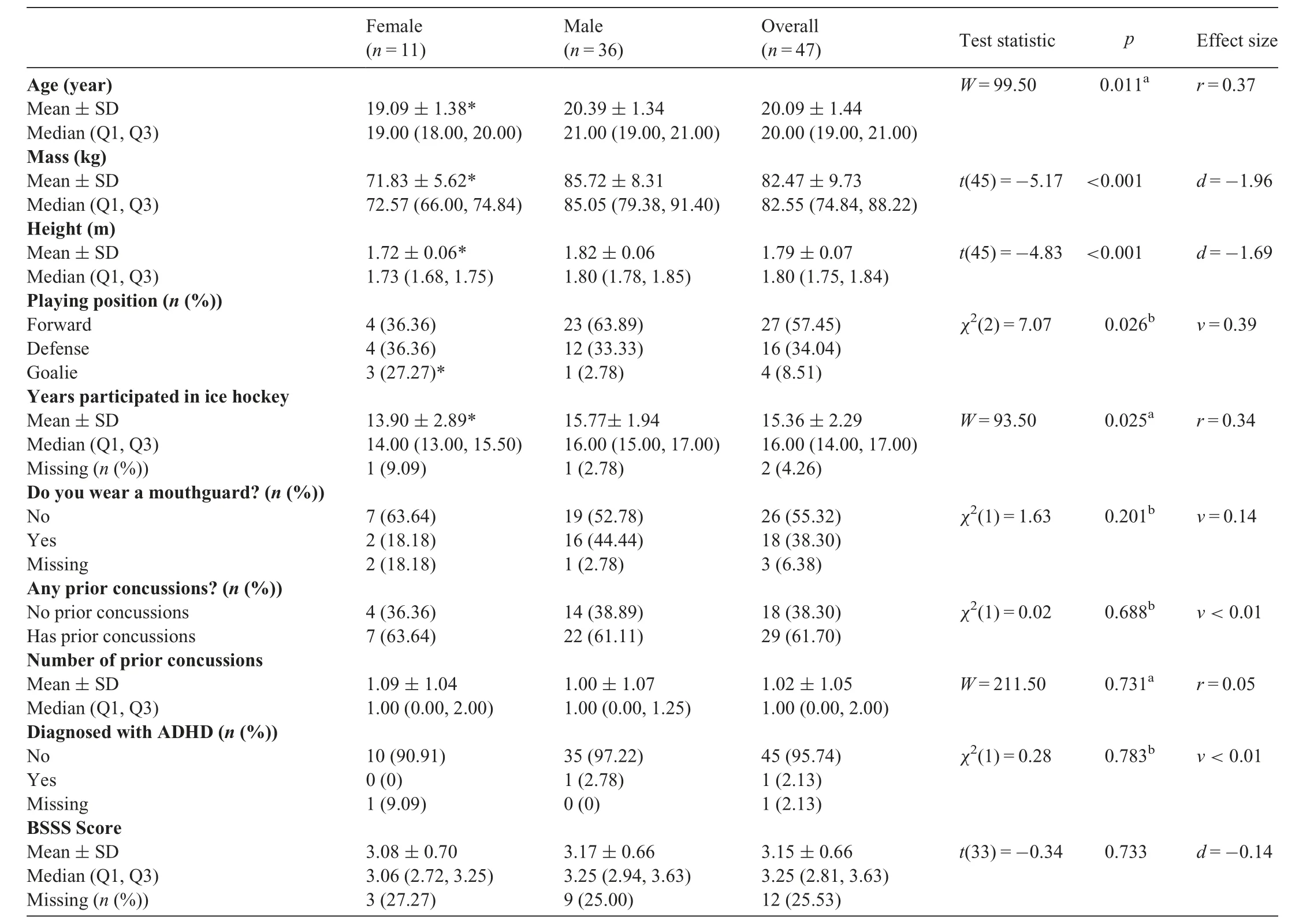
Table 3Concussed ice hockey participant baseline characteristics by sex.
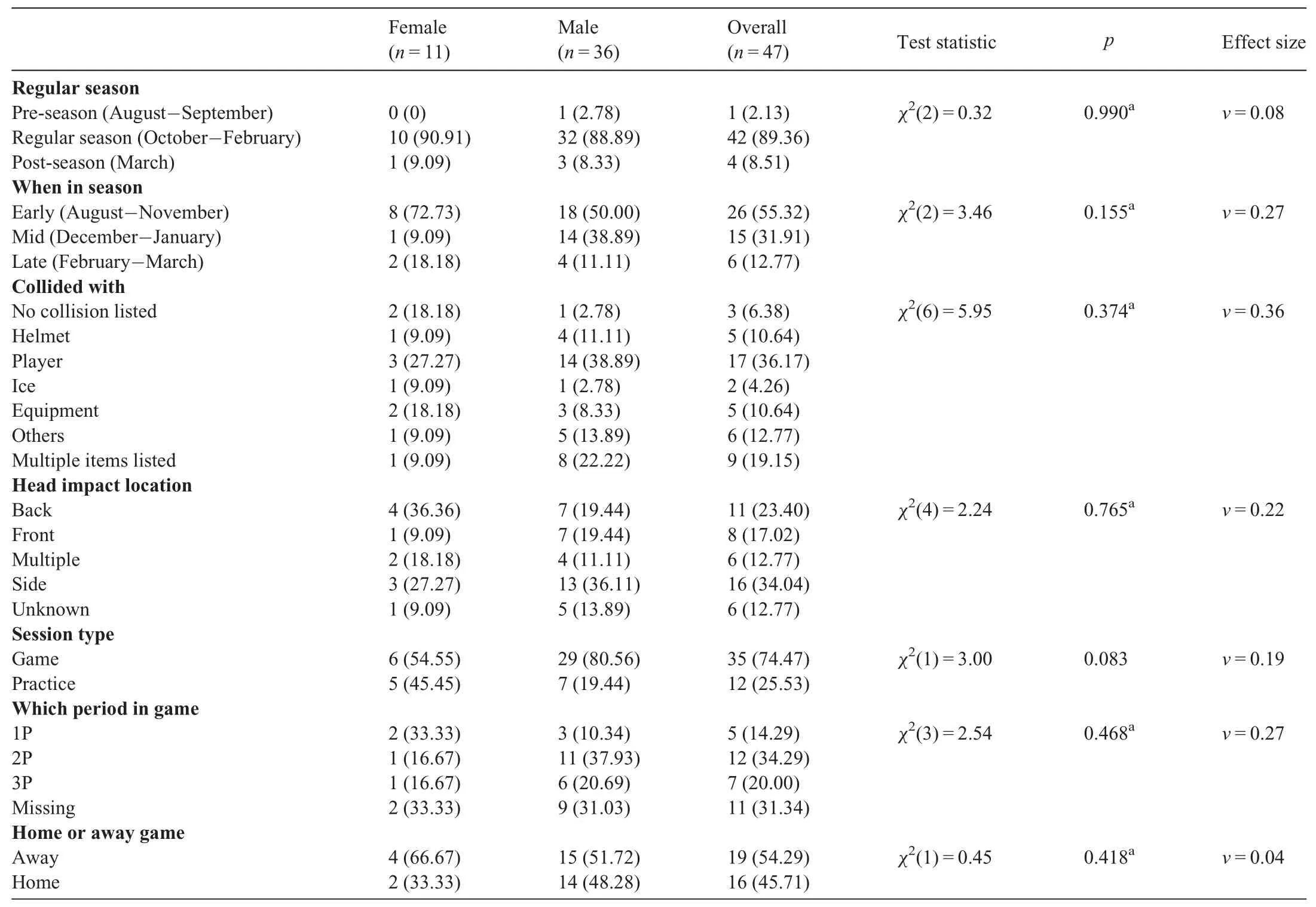
Table 4Ice hockey concussion timing,mechanisms,and settings by sex(n(%)).
Prior concussion and mouthguard use were the only significant estimators of concussion.History of at least one prior concussion was significantly associated with incident concussion(Z=2.03; p=0.043). Having a prior concussion was associated with 2 times the odds of concussion compared to those without a prior concussion (OR=2.00, 95%CI: 1.02-3.91).Athletes who reported using a mouthguard during their baseline assessment had 57% reduced odds of concussion compared to athletes who did use a mouthguard (OR=0.43;95%CI:0.22-0.85)(Fig.1).
To determine whether mouthguard use was a surrogate measure for risk-taking behavior, we compared BSSS scores among ice hockey players who reported using a mouthguard vs. those who did not.There was no significant difference in BSSS scores(W=8783.50;p=0.741)across mouthguard usage groups.
3.2. Ice hockey concussion characteristics between sexes
Between 2014 and 2017,there were 47(36 males,11 females)ice hockey players who sustained a concussion.Male ice hockey players were significantly older (p=0.011), taller (p <0.001),and heavier(p <0.001)than female players.In terms of hockeyspecific characteristics, there were fewer concussions among male goalies(p=0.026)than female goalies,and males had more years of ice hockey participation(p=0.025)than did their female counterparts.There were no other significant differences between sexes(p >0.05)(Table 3).
Overall, the concussion mechanism, setting, and timing did not significantly differ between sexes (Table 4). While most concussions occurred during the regular season, October was the single month with the greatest proportion of concussions(n=17;36.17%),indicating that concussions tend to occur early in the regular season. However, it is notable that while the vast majority of male concussions occurred during games (80.56%),only 54.55% of female concussions occurred during games.When looking at the collision and reported head impact location data during practices only,there were no differences in collision types(p >0.05)or head impact locations by sex(p >0.05).
When examining the clinical features of ice hockey concussions, male and females presented similarly with only a few specific differences (Table 5). There were significant sex differences in likelihood of delayed symptom onset and recovery. Females (9.09%) were less likely than males(41.67%) to have a delayed symptom onset (p=0.045)(Table 5). Additionally, females took significantly longer to reach asymptomatic (p=0.015) and RTP clearance(p=0.005) (Table 5; Fig. 2). Compared to males, females took a median of 12 more days until asymptomatic and a median of 16 more days to reach full RTP (Table 5; Fig. 2).When looking at the first 2 weeks post-concussion, 86.11%of males reached asymptomatic, while only 45.50% of females reached the asymptomatic phase of recovery. For overall recovery, most males (91.67%) were cleared for RTP within 3 weeks of their concussion, compared to less than half (45.50%) of females.
4. Discussion
Results from the current study identified specific concussion risk factors in ice hockey and indicated there were limited differences in concussion mechanisms or characteristics between sexes. Ice hockey players who had a concussion history had a 100% increased odds for another injury during the study period.Meanwhile,those ice hockey players who wore a mouthguard decreased their odds for concussion by 57%.While there were no significant differences in the mechanisms of concussions sustained during ice hockey for males vs.females, there were 2 notable trends. First, most of the male concussions occurred in midseason,while the vast majority of female concussions occurred in the early season. Second,while most male ice hockey concussions occurred during games as opposed to practices, females had a similar proportion of concussions occur in games and practices. The finding is interesting because practices, in comparison to games,should be structured to minimize contact.This suggests modifications in coaching may be able to reduce concussion incidence in female ice hockey players by reducing contact during practice.Notably,there were no differences in impact location or collision type between male and female ice hockey players despite different rules and game play.Finally,in terms of clinical differences, females were less likely than males to have a delayed symptom onset, but they took significantly longer to reach asymptomatic and RTP.
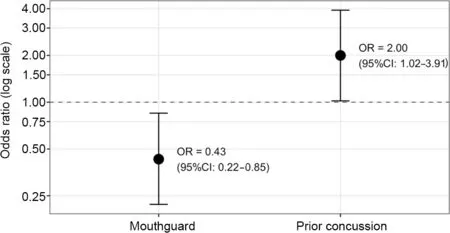
Fig. 1. Factors associated with incident concussion risk (odds ratios (OR)and 95%CIs). The OR is presented on the logarithmic scale. CI = confidence interval.
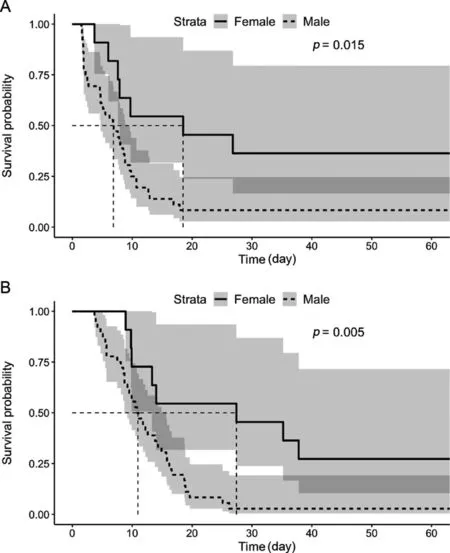
Fig.2. Survival analysis of (A) time until asymptomatic and (B) return-toplay clearance by sex: (A) survival analysis for time until asymptomatic with 95%CI; (B) survival analysis for days until return to play clearance with 95%CI. Log-rank analyses of p values are provided. Median survival is indicated by the horizontal and vertical dashed lines. CI=confidence interval.
The present study supports existing evidence that identifies concussion history as a concussion risk factor.11Furthermore,it extends and supports the findings of a previous study that showed mouthguards reduce concussion risk,15which had been in conflict with at least 2 other reports.30,31While in youth ice hockey players mouthguards were associated with a 49%-69%lower odds of concussion,15there had been no significant effect observed in professional hockey players.31The current study not only found a protective effect, but the effect size it found was of similar magnitude to that observed in youth hockey players.15Since mouthguard use is recommended in collegiate ice hockey, using a mouthguard might indicate lower levels of risk-taking behavior, a variable that may itself explain why concussion risk was reduced among players who reported using a mouthguard. Therefore, we also examined the association between BSSS scores and mouthguard use. Since there was no significant difference in BSSS scores whether or not an ice hockey player used a mouthguard,this suggests the effect of wearing a mouthguard may reduce concussion risk via other mechanisms.
Overall, concussion mechanisms were similar to those found in previous investigations of ice hockey players.8The current study found that 89% of concussions occur during the regular season,and it adds to the literature by identifying October as the month with the greatest proportion of concussions.Next,most concussions in the current study were due to collision with another player. Collision with another player was also the most common cause of concussions in other collegiate1,8and professional3ice hockey studies.However,unlike in previous collegiate studies,8we found that concussions due to player contact were not more common in men’s than in women’s ice hockey.That said,given our smaller sample size,the effect may not be detectible due to low power.
The current study demonstrated that the greatest proportion of ice hockey concussions occurred in game situations, which is consistent with the results from prior studies of concussions in ice hockey10and other collision sports. Unlike in professional ice hockey, where most concussions occur in the first period,3we found no significant association between period and concussion.While concussions were more common during the 1st period in women’s ice hockey and during the 2nd and 3rd periods in men’s ice hockey, the association between sex and period of play during which the concussion occurred did not rise to the level of statistical significance. However, this analysis may have been limited due to small sample size. We also found that while most concussions occurred during games, women’s ice hockey had a higher proportion of concussions occur during practice than did men’s ice hockey.The observed proportion of women’s ice hockey concussions during practice was approximately 20% higher than reported in previous studies of collegiate ice hockey.8Again,due to small sample sizes, especially with respect to women’s ice hockey concussions, this difference should be interpreted cautiously.Preliminary investigation of collision and reported head impact locations did not reveal any particular explanation for the higher number of concussions in practice.Future investigations should determine whether this finding is replicable and work to identify the cause of practice concussions in order to educate coaches as to how to run safer practices.
In terms of clinical characteristics, the current study found that males and females were equally likely to report their concussion immediately.In this way,the study echoes the conclusion of Asken and colleagues32while expanding it to collegiate ice hockey. Still, males were more likely to experience delayed symptom onset. This is notable because Olson and colleagues33found no difference in delayed symptom onset across males and females in their study of delayed symptom onset in a concussed pediatric population.Given the association between delayed symptom onset and immediate reporting,32male ice hockey players in the current study may have said their symptoms were delayed in order to continue playing. Previous education initiatives to improve knowledge and behavior with respect to concussion risk have found there was no increase in knowledge and little decrease in an individual’s intention to play with a concussion.34Since past interventions do not appear to have improved concussion reporting behavior in collegiate ice hockey players, other interventions should be considered to improve reporting. Informing players of the more immediate consequences of their behavior (e.g.,that their recovery could be longer if they delay reporting32or that they could see decreased performance when playing with a concussion35)may have a beneficial effect.
The current study found that females took significantly longer to reach asymptomatic and RTP clearance. Differences in statistical tests and methods for evaluating recovery time, as well as the small sample size in the current study, could explain the difference in results between this finding and that of Wasserman and colleagues.19However,there might also be psychological,physiological,and clinical management factors that contribute to the longer recoveries observed for females in the current study.Females are more likely to report more concussion symptoms, even at baseline.20Therefore, if clinicians do not account for the higher symptom reporting rate,females may take longer to reach asymptomatic due to differences in clinical management. In addition, females demonstrate impaired parasympathetic activity post-concussion,36which may signal a prolonged injury response.Most likely the cause of prolonged recovery in female ice hockey players is due to a mix of psychological, physiological, and management causes.However,future studies should investigate whether female ice hockey players are RTP late or male players are returning prematurely.
The current study is not without limitation. The relatively small sample size made multivariate analyses inappropriate and also restricted our power,which might be why some previous findings could not be replicated. The small sample size was most relevant with respect to male and female comparisons of ice hockey concussions. With fewer women’s than men’s ice hockey teams involved in the CARE Consortium and the NCAA overall, fewer concussions occurred in female players, thereby reducing the sample size in the current study quite dramatically. The small number of comparisons available,especially relative to concussion mechanisms and characteristics,could have increased the chances of observing a false positive.The effect sizes should be considered when interpreting the results.
Another limitation of the current study is that it only evaluated diagnosed concussions.Since up to 30%of concussions go unreported and undiagnosed,17,37there could be a large portion of concussion mechanisms and clinical features that were not captured. Additionally, our measure of mouthguard use, which was determined during the pre-season baseline assessment, may not reflect actual mouthguard use.Actual mouthguard use and adherence at the time of injury, along with the type of mouthguard(custom fitted vs.generic),would also have been useful information. However, previous studies have found good agreement between pre-season self-reported mouthguard use and actual mouthguard using during play,15indicating that athletes most likely behave the way they report at baseline. While females were found to be less likely to have delayed symptom onset,this could also be confounded by delayed reporting. Future studies with larger female samples should evaluate the relationship between delayed reporting, delayed symptom onset, and sex.Finally, the current study did not collect exposure data or head impact exposure data,which would have been useful in offering strong predictors of concussion.38
5. Conclusion
Previous concussion and not using a mouthguard are associated with substantially increased concussion risk in collegiate ice hockey. Overall, there were no substantial differences in concussion mechanisms between male and female ice hockey players, although there were specific differences in how concussions presented clinically. Female ice hockey players took longer than their male counterparts to become asymptomatic and to be cleared for full RTP.Understanding specific risk factors, concussion mechanisms, and clinical profiles of concussion in collegiate ice hockey may generate ideas for future concussion prevention or intervention studies.
Authors’contributions
KLVP designed the study, performed the statistical analysis, reviewed analyses, and drafted the manuscript; JBC and TAB designed the study, reviewed analyses, and drafted the manuscript; JTE, MP, BMA, KLC, MNH, MAP, JCJ, GTM,and CJH coordinated and completed data collection at study site, reviewed analyses, and drafted the manuscript; TWM,MAM, and SPB developed and designed the parent CARE study, reviewed analyses, and drafted the manuscript. All authors have read and approved the final version of the manuscript,and agree with the order of presentation of the authors.
Competing interests
The authors declare that they have no competing interests.
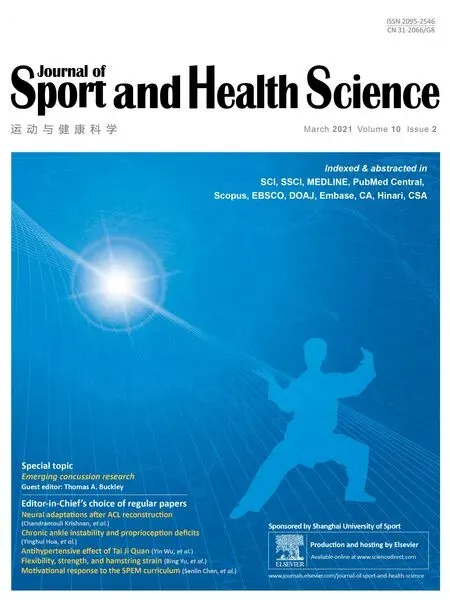 Journal of Sport and Health Science2021年2期
Journal of Sport and Health Science2021年2期
- Journal of Sport and Health Science的其它文章
- Concussion research:Moving beyond the natural history
- Author biographies
- Learners’motivational response to the Science,PE,&Me!curriculum:A situational interest perspective
- Effects of chronic decaffeinated green tea extract supplementation on lipolysis and substrate utilization during upper body exercise
- Training load characteristics and injury and illness risk identification in elite youth ski racing:A prospective study
- Effects of flexibility and strength training on peak hamstring musculotendinous strains during sprinting
